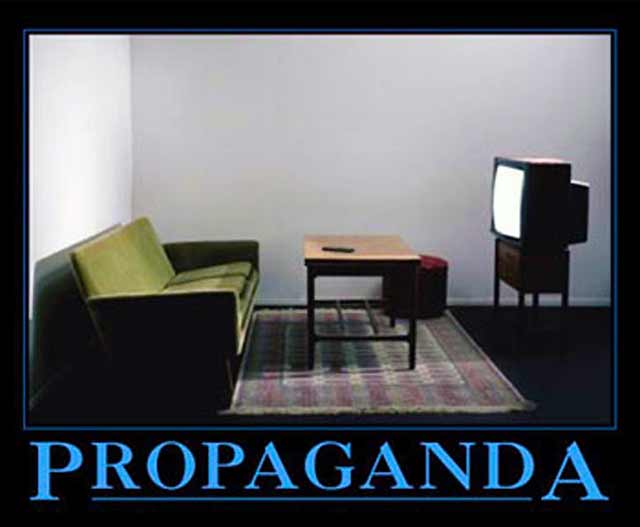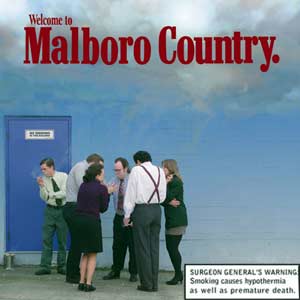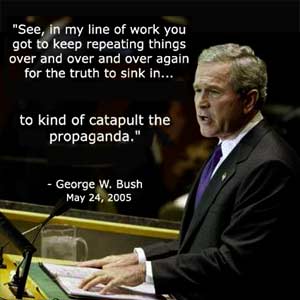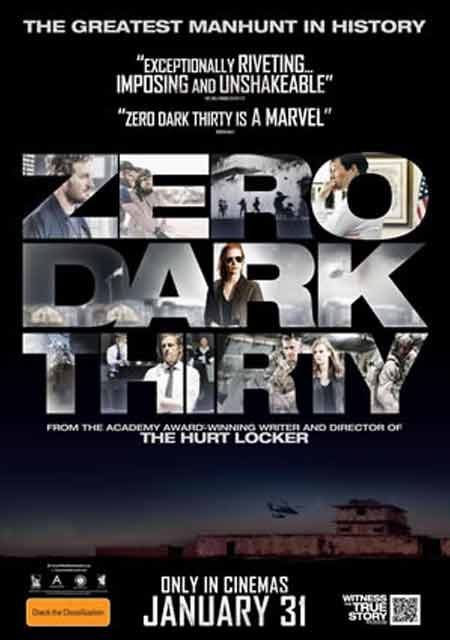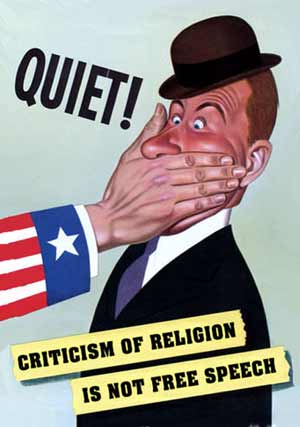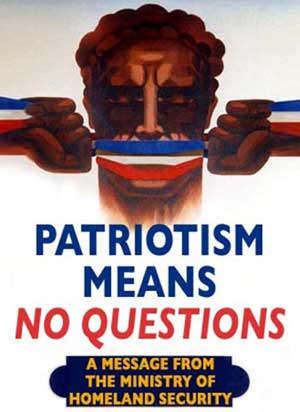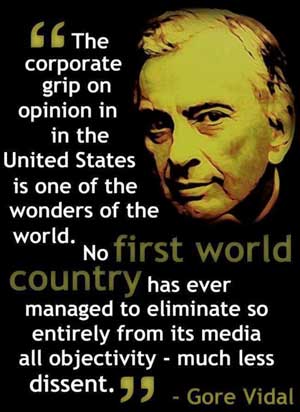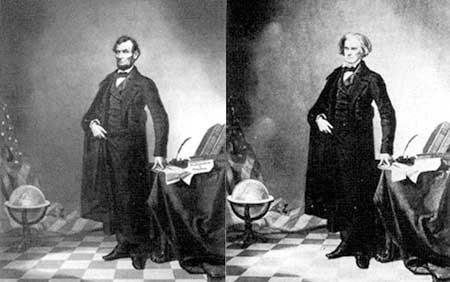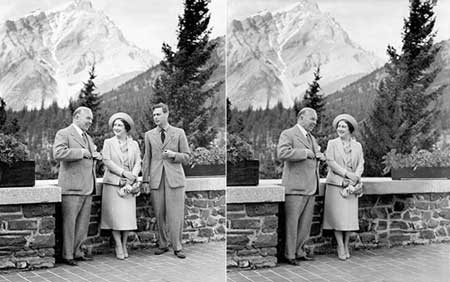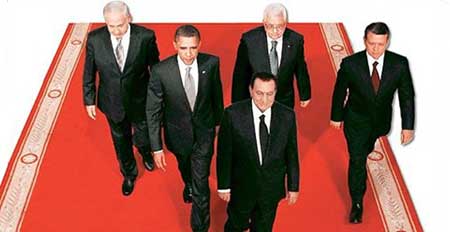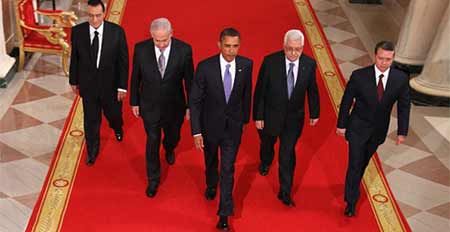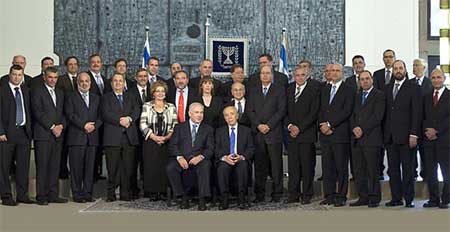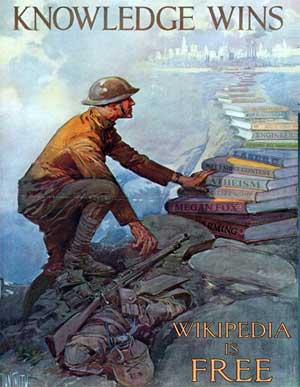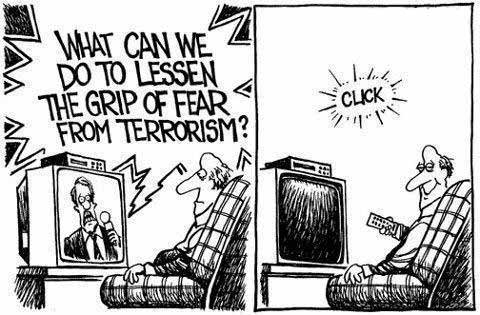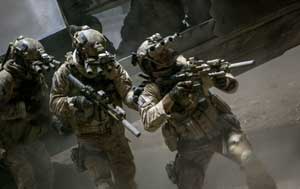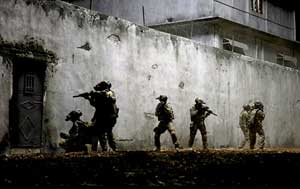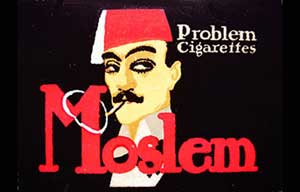We must remember that in time of war, what is said on the enemy’s side of the front is always propaganda,
and what is said on our side of the front is truth and righteousness, the cause of humanity, and a crusade for peace.
Passion, Hatred, Folly, Greed
May 16, 2013
I try to learn something each time I post. And I don’t consider myself to hold extreme beliefs (though my post on bin Laden’s death cost me readers who interpreted my concerns as subversion, an attitude with which I disagree, but I’m open to discussion). Though I emotionally believe I try to present a topic without (notable) bias, intellectually, I know that’s unlikely-to-impossible. Many “facts” I’m automatically certain of turn out to be totally wrong and deluded. Furthermore, my opinions aren’t always my own — I sometimes succumb to propaganda. We all do. Nothing is free from propaganda — nothing. Nor has it ever been.
Background
First off, a definition of sorts:
Propaganda
1 the spreading of ideas, information, or rumour for the purpose of helping or injuring an institution, a cause, or a person.
2 ideas, facts, or allegations spread deliberately to further one’s cause or to damage an opposing cause; also, a public action having such an effect. Propaganda is generally an appeal to emotion rather than intellect.
While the term propaganda has acquired a strongly negative connotation, in its original sense it was neutral and could refer to generally benign or innocuous uses such as public health recommendations, signs encouraging citizens to participate in a census or election, messages encouraging persons to report crimes to law enforcement, to use seatbelts, or to stop smoking. I assume that what sets propaganda apart from other forms of advocacy is the willingness of the propagandist to change people’s understanding through deception or confusion rather than persuasion and understanding.
I feel the burden of vigilance regarding the veracity of information being received must rest with the individual. Each person must for himself assess which information he wishes to accept as true and which to reject. The internet facilitates fact-finding exponentially from what was commonly available hardly more than a generation ago. Yet information should never be served up on a single plate. It’s important to understand opposing viewpoints on every significant issue — even if you don’t (for whatever reason) vote, you still should be able to hold forth rational opinions to the people with whom you interact on the important issues of the day.
To recognise propaganda, you must not only think, but think about thinking. We all filter out facts counteracting our preconceptions (an efficient habit often hijacked for propaganda purposes). Is it any wonder advertisers and PR flaks push our attention envelopes to their advantage? They have families and bills and are motivated to be successful the same as everyone else. Even at a personal level, imposing (promoting) your views to someone else is propaganda, though in a friendship situation, it’s called something else (like maybe “friendly advice” or “my opinion”).
By itself, propaganda is neither good nor bad — it just is. Propaganda can effectively rally people behind a cause. But to unite a widely disparate group is going to require exaggeration, misrepresentation, or even lies. That’s what this post is intended to illustrate.
Common propaganda tactics include:
- telling selective stories meant to apply widely and sound objective,
- relating only those facts which facilitate goal achievement,
- offering explanations for the importance of goal achievement such that the intended goal seems to offer increased safety,
- using unverified facts presented in dramatic ways followed by any disclaimers the law requires (de-emphasized, of course),
- demonising those who are “against us” (while “against” may cover a wide range of positions, not just a single one),
- using a narrow range of discourse that serves narrow interests (think slogans and jingles).
Sometimes media accept as given the very policy positions they should be critically examining.
Propaganda Methods
Name Calling is trash-talking a product or person, mudslinging, or using ad hominem attacks (belittling the person rather than refuting the argument). In its extreme form, name calling may indicate that the propagandist has lost his sense of proportion or is unable to conduct a positive campaign. Before using this technique, the propagandist must weigh the benefits against the possible harmful results. (Examples are Rush Limbaugh’s attack on Michael J Fox, JibJab parody movies, Ann Coulter on liberals, liberals on Sean Hannity, and gazillions more.)
Glittering Generalities technique uses important-sounding “glad words” that have little or no meaning. These words are used in general statements neither able to be proved nor disproved. Words like good, honest, fair, and best are examples of glad words. While Name Calling seeks to make us form a judgment to reject and condemn without examining the evidence, the Glittering Generalities device is Name Calling in reverse — it seeks to make us approve and accept without examining the evidence. Generalities may gain or lose effectiveness with changes in conditions. Phrases which called up pleasant associations at one time may evoke unpleasant or unfavourable connotations at another time. (“Come Alive! You’re in the Pepsi Generation!”)
Testimonials are quotations (in or out of context) especially cited to support or reject a given policy, action, programme, or personality. This includes famous people recommending products and making political endorsements. (“New Jersey Democrats endorse Hillary Clinton for President!” or what happens when Britney Spears hawks Pepsi, or George Clooney promotes Nespresso.)
Plain Folks technique is designed to get ordinary citizens to identify with a political candidate or other figure (with whom they otherwise would have nothing in common) by having the candidate hunt, fish, kiss babies, kiss the spouse in public, and attend church. (The Sherrod Brown for Senate campaign ad talked about “plain folks’ values.” Bill Clinton ate at McDonald’s and confessed a fondness for trashy spy novels. George Bush Sr hated broccoli.) And of course George W Bush was a master of this technique. With this device, the propagandist can win the confidence of persons who resent or distrust foreign sounding, intellectual speech, words, or mannerisms.
Bandwagon encourages the viewer or listener to join the crowd by aligning with the most popular, successful side of an issue; this techniques plays to the human desire to be on the winning team or to feel superior to others. (“You should have sunglasses. Everyone else has them.”)
Card-Stacking involves manipulating information to make a product appear better than it is, often by unfair comparison or by omitting facts; although the information presented is usually true, it’s a lopsided, unrealistic, deceptive viewpoint. This technique is often used in product advertisements. (Comparison between Apple Macintosh and Windows operating systems frequently used this technique.) Censorship is a form of card-stacking.
Transfer technique is also known as Association and is used when a group, product, or person attempts to align with a symbol in an effort to transfer the status of the symbol to the cause being represented. The cross stands for the Christian Church. The flag represents the nation. Cartoons using Uncle Sam represent a consensus of public opinion. Those symbols stir emotions. (Old television commercials for cigarettes and alcohol often used this technique, showing beautiful people playing tennis at the country club or out on their yachts.) This technique is also used to transfer blame from one member of a conflict to another by evoking an emotional response which stimulates the target to identify with recognised authorities.
Fear techniques are designed to scare people into choosing sides. (“If you aren’t with us, you’re with the terrorists!”) This is also called the Either/Or Fallacy (though perhaps that’s a False Equivalence). This is a useful propaganda tool during election time. (A letter from a pro-gun organisation may begin by describing a lawless America in which only criminals own guns, and conclude by asking readers to oppose a ban on automatic weapons.) (Should the previous sentence have said assault weapons rather than automatic weapons?)
Logical Fallacy techniques make huge predictions about the future on the basis of a few small facts. (“If Congress passes legislation limiting the availability of automatic weapons, America will slide down a slippery slope, which will ultimately result in the banning of all guns, the destruction of the Constitution, and a totalitarian police state.” “I didn’t do it. Nobody saw me. You can’t prove it.”)
Euphemisms, since war is particularly unpleasant, are often used in military discourse. In the 1940’s, America changed the name of the War Department to the Department of Defense. Under the Reagan Administration, the MX-Missile was renamed “The Peacekeeper.” During wartime, civilian casualties are referred to as “collateral damage” and the word “liquidation” is used as a synonym for “murder.” Comedian George Carlin notes that, in the wake of the First World War, traumatised veterans were said to be suffering from “shell shock.” That short, vivid phrase conveyed the horrors of battle — one can practically hear the shells exploding overhead. After the Second World War, people began to use the term “combat fatigue” to characterise the same condition. The phrase was a bit more pleasant, but still acknowledged combat as the source of discomfort. In the wake of the Vietnam War, people referred to “post-traumatic stress disorder,” a phrase completely disconnected from the reality of war altogether.
Propaganda Types
Religious propaganda is used to spread the word about particular moral and ethical issues, including abortion and the controversy over religion in schools.
Patriotic (this includes War) propaganda is produced by or for governments and increasingly plays to emotions, depicting men as heroes and the people at home as the backbone of the country.
Political propaganda is commonly used to recruit and retain voters via a seemingly endless stream of television commercials, which sometimes depict only the best qualities of the candidates shown. Other versions utilise Name Calling, Fear, and other techniques to discredit opposing candidates or ideas.
Sales and Marketing (includes Brand Loyalty, and Group Memberships) techniques are pretty self-explanatory.
The simple truth is that few organisations, politicians, religions, or manufacturers are going to voluntarily disclose information that disputes their beliefs and goals. The most effective propaganda relies on framing rather than falsehood, bending the truth rather than breaking it, using emphasis and other auxiliary embellishments, or creating a desired impression without explicitly advocating a position or departing too far from the appearance of objectivity. This is achieved in the way the news is packaged, exposed, placed, its tone of presentation (sympathetic or slighting), headlines and photographs, and (for broadcast media) visual and auditory effects.
Religion
Religion is a way to express culture and to engage in social behaviour. Every culture and society in human history has had some kind of religion. With religion comes traditions, rites of passages, festivities, gatherings, holidays, celebrations, and so forth. Religion satisfies humanity’s urge to be social and to establish (and pass on) traditions and customs. Religion also serves to explain the unexplainable, provide hope, and ease tensions and anxieties (particularly among early humans). What better way to ease the concerns of a fisherman about to venture out on the ocean in a rickety boat in order to feed his family than to tell him the village holy man has petitioned the god(s) for his safe voyage?
The darker side of religion is used by people of power to control the masses and to serve a political, cultural, and/or financial agenda. Religion is not merely propaganda, it does have inherent social functions. Does it get used for propaganda purposes and misinformation? Absolutely. Good is done by religion or in the name of God — like charities, counselling, or Samaritans helping others. Bad actions also happen in the name of religion — holy wars, Islamic terrorism, Crusades, and bigotry toward other faiths or toward atheists.
Why employ a blunt instrument of state repression if people can be convinced to repress themselves? This is precisely what happens with unwelcome criticisms of religion, especially in the West where nations have little to no authority to officially censor material critical of religion. The most common way is to claim that non-adherents of a religion should not “offend” religious believers by criticizing their faith. This argument is based on the idea that criticism of a belief system is the same as a personal attack on the believers. Believers feel that they and their religion should be respected and, therefore, attacks on religion are not a valid use of free speech. But beliefs which are true and valid shouldn’t be harmed by even by unfair and incorrect criticism. Attacks on free speech most recently have primarily come from Muslims and Scientologists. Some threaten violence or lawsuits if ideas, images, or words deemed offensive are given public expression.
Patriotism / War
Plato observed that a democratic system of rule allows the few to govern on behalf of the many. Successful rule by the few must placate the many, especially for defence of the state and regarding the conduct of war. In some countries, the military offers incentives to join (good salary, subsidised education) which appeals to certain segments of society — defending one’s democracy may not be the prime reason for joining the military. People may also be free to choose not to participate in a military, and/or to vote to reduce the proportion of public funds allocated to it. Hence, a lot of fear-based propaganda may be employed to gain support for excessive military spending or to wage war. In times of war or build-up to war, messages of hate combined with emotions of honour and righteousness interplay to provide powerful propaganda.
The first casualty when war comes is Truth.
— US Senator Hiram Johnson, 1917
Many say it’s inevitable in war that people die. Perhaps. But in many cases the war itself isn’t inevitable; propaganda is employed to move a populace closer to war. Civilian casualties are unfortunately almost a guaranteed certainty. Those who promote the negative image of the “enemy” may often reinforce it with rhetoric about their own righteousness in an attempt to muster support and nurture belief that war brings a positive and beneficial interest for everyone (for the survivors, anyway). Often, the principles used to demonise the Other aren’t used to judge one’s own country (sometimes leading to accusations of double standards and hypocrisy).
Next the statesmen will invent cheap lies, putting the blame upon the nation that is attacked, and every man will be glad of those conscience-soothing falsities,
and will diligently study them, and refuse to examine any refutations of them; and thus he will by and by convince himself that the war is just,
and will thank God for the better sleep he enjoys after this process of grotesque self-deception.
— Mark Twain, The Mysterious Stranger, 1916, Chapter 9
The tactics of war propagandists:
- Minimise the reasons for unresolved conflicts and polarization.
- Reduce the number of parties in a conflict to two (when often more are involved).
- Always portray one side as good and the other evil (not merely mistaken).
- Present war as inevitable; omit alternatives.
- Focus on individual acts of violence while avoiding structural causes (poverty, government neglect, military or police repression).
- Focus only on the conflict arena, not on factors influencing events, such as acts of revenge and spirals of violence.
- Don’t explore causes of escalation and the impacts of negative media coverage.
- Don’t mention the goals of outside interventionists, especially big powers.
- Don’t confuse people with talks of possible peaceful alternatives.
- Do confuse cease-fires and negotiations with actual peace.
- Omit reconciliation: conflicts re-emerge if no attention is paid to healing efforts.
The Preliminary Stage (the crisis) is when news outlets begin reporting “mounting concern” over some poverty/dictatorship/anarchy which negotiations appear unable to resolve.
The Justification Stage occurs when news outlets report increasing urgency for armed intervention to bring about a rapid restitution of some norm. (There’ll always be a “dead baby” story that proves there’s no time for diplomacy, cool deliberation, or negotiating on peace proposals. In the lead-up to the 1991 Gulf War, a US public relations firm got the Kuwaiti Ambassador’s 15-year-old daughter to pose as a nurse, claiming to the US Congress that she saw Iraqi troops killing babies in hospitals. The purpose was to arouse the public and demonise Iraq, thus making a declaration of war more acceptable. Actually, the “nurse” hadn’t been to Kuwait in many years.) Comparing the enemy’s leader to Hitler is usually helpful, as is suggesting the opposition leader is insane.
The Implementation Stage is where news pooling and censorship influence the degree of independent investigation and independent coverage. War correspondents have short working lives with no tradition or formal means of passing on knowledge and experience of war reporting to future replacements. The military, on the other hand, is an institution that goes on forever. They’ve learned to use PR firms to manage public perceptions of their performance.
The Aftermath Stage is when normality is portrayed as returning to the region. This campaign is now less needful of positive public opinion and can subsequently depend on simple, repetitious and emotional phrases (for example, war on terror, axis of evil, weapons of mass destruction, shock and awe, war of liberation) to reinforce common perception of the campaign’s success.
A series of Islamophobic ads erected in several locations in New York’s extensive subway system caused a bit of an uproar.
Since their subsequent appearance on the sides of San Francisco’s buses, they have become the subject of a degree of civil unrest.
Many observers of the ad read it as calling all Muslims or Palestinians savages.
After the end of the American Civil War, journalist F Colburn Adams wrote, “Future historians will have [a] very difficult task to perform sifting truth from falsehood as it appears in official records.”
The military’s mission is to fight and to win, whatever conflict may present itself: on the battlefield, in public opinion, and in history books. A journalist, on the other hand, is a sceptic or cynic whose aim is to seek, find, and report truth — a mission both parties often view as incompatible with successful warfare. The issue of war correspondent duties is the challenge of patriotism versus professionalism. Governments, understandably, put a priority on nurturing the morale of the armed forces. They have few scruples about whether they’re being fair and just if their propaganda demonises an alien leader or even a whole population. (The enemy does the same.) Wars generate a competitive ecstasy of hate, a duel in vicious stereotypes and headlines. Only after a conflict is there time enough to sift the ashes for truth. History knows now that the Germans did not, as charged in World War I, toss Belgian babies in the air and catch them on bayonets, nor boil corpses for glycerine for munitions — stories invented by a British correspondent pressed by his office for news of atrocities. The French didn’t, as the German press reported, routinely gouge out the eyes of captured German soldiers, or chop off their fingers for the rings on them. Iraqi soldiers invading Kuwait did not toss premature babies out of incubators. Myths galvanise public opinion at a critical moments on the need to go to war — as intended.
History is a mausoleum of errant emotions: Who is the more patriotic — the government that conceals the blunders its soldiers endure (and the cruelties they may inflict), or the correspondent who exposes these blunders so that they might be rectified? (Think Wikileaks.) Is one’s first duty is to humanity, to one’s country, to one’s family, or to one’s self?
Before the Iraq War, the US said it would support efforts to get a second UN resolution on Iraq, and to that end, it would “twist arms” and “even threaten.” Bush said, “If ultimately we fail [to get the second resolution], military action will follow anyway.” Blair responded that he was: “solidly with the President and ready to do whatever it takes to disarm Saddam,” adding: “a second Security Council resolution will provide an insurance policy against the unexpected, and international cover, including with the Arabs.” Because the Weapons of Mass Destruction (WMD) inspection teams were not finding evidence of WMDs in Iraq, other option were considered. Bush said, “The US is thinking of flying U2 reconnaissance aircraft with fighter cover over Iraq, painted in UN colours. If Saddam fires on them, he’ll be in breach.” Bush added that, “It’s also possible that a defector could be brought out who’d give a public presentation about Saddam’s WMD” and “a small possibility that Saddam will be assassinated.”
The UK Foreign Office didn’t deny this meeting took place, nor did they question any content as presented by Channel 4 and eventually many news sources around the world. There was surprise, outrage and concern that the US entertained the thought of deceiving the world into war by flying an American spy plane but with UN colours. However, as illegal and immoral as that might be, it’s not without precedent. For example, the US staged the “Gulf of Tonkin” incident in 1965, making it look like the North Vietnamese attacked the South so the US could justify a declaration of war. The National Security Archive project in Washington DC revealed that the US Joint Chiefs of Staff considered Operation Northwoods as a pretext for invasion of Cuba in 1962 by assassinating Cubans in Florida, creating fake communism terror campaigns in Florida and Washington DC, fake Air Force attacks, the sinking of Cuban refugee ships (real or fake) and blaming it all on Cuba’s dictator Fidel Castro. History is rife with such examples — it’s how power works. While opinions differ on whether the US and UK were correct to invade Iraq, the manner in which they went about convincing the world to support them is under question and scrutiny. Leadership in even the most advanced countries use spin, deception, and lies just as they accuse adversaries of doing.
Politics
Most democracies hold elections at least every 4 or 5 years. The short life span of elected officials prevents a party becoming entrenched, dictatorial, stagnant or less caring of the general population over time. Yet short-termism has problems, too. Political leaders manipulate media and use sound-bites and emotive slogans rather than reasoned public debate to get elected.
During the Iranian hostage crisis (November 1979-January 1981) Iranian students held 52 Americans hostage for over a year. Reagan was challenging Carter in the US presidential race. Reagan and George H W Bush struck a deal with the Iranian mullahs to provide weapons if they released the hostages the day after Reagan was sworn in as President, rather than doing it sooner, during Carter’s term. In another instance, in the summer of 1968, Nixon feared a breakthrough at the Paris Peace talks designed to find a negotiated settlement to the Vietnam War because it would derail his presidential campaign. He therefore set up a clandestine back-channel involving a senior campaign adviser. The South Vietnamese ambassador was told the adviser represented Nixon and spoke for the campaign. In late October 1968, there were major concessions from Hanoi which promised to allow meaningful talks to get underway, concessions justifying Johnson calling for a complete bombing halt of North Vietnam. This was what Nixon feared. Nixon’s campaign adviser was dispatched to the South Vietnamese embassy to tell the South Vietnamese government to withdraw from the talks and refuse to deal with Johnson. Once Nixon was elected, they were told they’d get a much better deal. On the eve of his planned announcement of a halt to the bombing, Johnson learned the South Vietnamese were pulling out. The FBI had bugged the ambassador’s phone and transcripts of the campaign adviser’s calls were sent to the White House. Johnson was told that the interference was illegal and threatened the chance for peace. He ordered the Nixon campaign placed under FBI surveillance, but feared that going public would reveal that the FBI had bugged the ambassador’s phone. Johnson decided to say nothing, even though Nixon had committed what was arguably treason (and the war continued for another 5 years at a cost of thousands of lives). In another instance, the US government decided the sentencing of Saddam Hussein would take place just before the 2006 mid-term elections so as to give the appearance of a successful action coming to a close.
Propaganda may be administered in insidious ways. For instance, disparaging disinformation about the history of certain groups or foreign countries may be encouraged or tolerated in the educational system. Since few people actually double-check what they learn at school, such disinformation will be repeated by journalists as well as parents, thus reinforcing the idea that the disinformation item is really a “well-known fact,” even though no one repeating the myth is able to point to an authoritative source. To succeed, democracy must remain transparent and objective. But it just doesn’t.
Naturally the common people don’t want war: neither in Russia, nor in England, nor for that matter in Germany. That is understood.
But, after all, it is the leaders of the country who determine the policy and it is always a simple matter to drag the people along,
whether it is a democracy, or a fascist dictatorship, or a parliament, or a communist dictatorship.
Voice or no voice, the people can always be brought to the bidding of the leaders. That is easy.
All you have to do is tell them they are being attacked, and denounce the peacemakers for lack of patriotism
and exposing the country to danger. It works the same in any country.
— General Herman Goering, President of German Reichstag and Nazi Party, Commander of Luftwaffe during World War II, April 18, 1946.
(This quote is said to have been made during the Nuremburg Trials, but in fact, while during the time of the trials,
was made in private to an Allied intelligence officer, later published in the book, Nuremburg Diary.)
In the eyes of the West and its media, the deaths of 5,000-odd people in terrorist attacks launched by Al Qaeda and its affiliates in the last 5 years is the ultimate threat to global security. In the eyes of Arab public opinion, the deaths of 50,000-500,000 innocent people in Iraq, Afghanistan, Lebanon, and Palestine is the real tragedy. Each side forgets that, while their woes are serious, some 50 million children have died since 9/11 due to neglect, starvation, and deprivation by a world overly obsessed with other concerns.
Media watchdog, Fairness and Accuracy In Reporting (FAIR) found that 92% of all US sources interviewed were white, 85% male, and (where party affiliation was identifiable) 75% Republican. Artists Nora Ligorano and Marshall Reese created an exhibit called “Line Up” depicting photographs of George W Bush and members of his administration doctored to look like mug shots. (The artists were critical of the war in Iraq.) Their exhibit was shown at the New York City Public Library. “It’s simply inappropriate to have political attack art, in the form of egregious doctored photographs of the President and other high-ranking officials who have dedicated their lives to public service, in a taxpayer-funded building frequented by schoolchildren and the general public,” said the director of communications for the state GOP. The library said the exhibit was in keeping with a historical tradition of political commentary. Both sides have a point.
US President Barack Obama gave a commencement address to the graduating class of Ohio State University in which he said: “Unfortunately, you’ve grown up hearing voices that incessantly warn of government as nothing more than some separate, sinister entity at the root of all our problems. Some of these same voices also warn that tyranny lurks just around the corner. You should reject these voices. Because what they suggest is that our brave, creative, unique experiment in self-rule is somehow just a sham with which we can’t be trusted. We’ve never been a people who place all our faith in government to solve our problems. We shouldn’t want to. But we don’t think the government is the source of all our problems, either, because we understand that this democracy is ours. As citizens, we understand that it’s not about what America can do for us, it’s about what can be done by us, together, through the hard and frustrating but absolutely necessary work of self-government. And class of 2013, you have to be involved in that process.” Count the number of propaganda techniques used! (And this it only a tiny excerpt).
- This iconic portrait of US President Abraham Lincoln is actually a composite of Lincoln’s head and the Southern politician John Calhoun’s body around 1860.
- William Lyon Mackenzie King trained as a lawyer and worked as a professor before becoming a politician, eventually rising to the office of Prime Minister, where he served for 21 non-consecutive years. He decided to doctor a photograph, taken in 1939, of King George VI, Queen Elizabeth (the Queen Mother), and himself at Banff National Park in Alberta. In the original photo, the 3 enjoy a laugh amid the scenery. However, later George was painted over with a tree and some flowers, though the shadow where he was standing is still visible, and the bricks underneath look warped. (By today’s standards, the doctoring job is almost childish.) However, this forgery was good enough to fool the Canadian public, and was used in a campaign poster for the Prime Minister’s re-election bid. Historians aren’t quite sure why King had George removed, but many believe that it was to look like he was in charge as, without George, it looks as if the Queen is looking up to him.
- It only came to light sometime after the event that the newspaper Al-Ahram (published in Cairo and heavily influenced by the government), doctored one of the photographs taken at the Middle East summit meeting in Washington DC.
- In the original photograph President Barack Obama is seen walking at the front, with the Israeli prime minister, Benjamin Netanyahu, and the leader of the Palestinian Authority, Mahmoud Abbas, behind him to the left and right respectively. They’re followed on the right by the king of Jordan, while to the left and somewhat behind the group is Hosni Mubarack, the Egyptian president. As this arrangement wasn’t to the liking of the daily paper, they “adjusted” the photograph to positioned the Egyptian politician at the front of the group, suggesting that despite the possible failure of the talks, their country’s president remained an authoritative political player.
- The Israeli newspaper Yated Ne’eman published this version of a group photo of Netanyahu, the country’s newly elected Prime Minister, front left, with President Shimon Peres, front right, and members of Netanyahu’s new government.
- The unaltered version of the photo reveals that the newspaper replaced the two female Cabinet members, Limor Livnat and Sofa Landver, with men’s faces. The faces belong to ministers Ariel Atias and Moshe Kachlon, who in the original photograph can be seen toward the periphery of the group (standing, second from left and second from right). Much of Yated Ne’eman's readership consists of ultra-Orthodox readers who don’t think it proper for women to serve in the government.
Selling
There’s an invisible force operating within the US, and it will always exist so long as people “need food, crave amusement, long for beauty, respond to leadership.” That invisible force is the power of advertising persuasion. It isn’t limited to selling product — the executive arm known as the Public Relations counsel “sells” even the chief executive, who is stage-managed and manipulated in the public arena in order to achieve certain goals. Whose goals exactly? Perhaps those shrewd persons operating behind the scenes. The public generally doesn’t realise that it’s being directed and influenced to make certain decisions.
How are individuals influenced? Through personalities and authority figures the individual admires and/or respects as well as through movies. An individual can becomes “stamped” by group influences, thereby ceasing to be a distinct “cell” but part of a larger organism with “group prejudices” that can be swayed and directed much like a shepherd directing sheep. (Political leaders are given to us as manufactured products that reflect the personalities our “group” prefers.) For an example of stamping, but on a much more personal level, think of Google. If you and a friend on the other side of the country or (even better) in a different country each search for the same term, you’ll be highly unlikely to be returned the same results in the same order. You’ll be given results in line with your profile. If you’re ecologically-minded and search for a political topic, the results may be skewed toward Greens’ sites. This may suit you just fine — but it unfortunately makes you feel that your group is more prominent than may perhaps be the case.
- San Francisco-based ad agency Goodby, Berlin & Silverstein installed a video camera behind a refrigerator to monitor the reaction of people who “unexpectedly” ran out of milk. The study concluded that people really despise being out of milk. This important insight about milk deprivation laid the ground work for the 'Got Milk’ advertising campaign.
- In David Berman’s book Do Good Design, he talks about how before the “Joe Camel” cartoon character appeared in the 1980s, Camel cigarettes had 1% of the US teen cigarette market. By the time the campaign was stopped in 1997, Camel had 32% of this market. More than 90% of 6-year-olds could recognise Joe (more than knew Mickey Mouse).
- Artist Brian Moore has made a series of imaginary World War III propaganda posters that take some of the most iconic images from World War I and World War II and reinvent their messages for our modern technological world. (Click on the image for closeup detail.)
Concerns
The US Pentagon defines “perception management” as “actions to convey and (or) deny selected information and indicators to foreign audiences to influence their emotions, motives, and objective reasoning. In various ways, perception management combines truth projection, operations security, cover, deception, and psyops [psychological operations].” Perhaps “propaganda” is too loaded a word? Note that perception management is for “foreign audiences”! If one’s own citizens are targeted to convince them to support a war or make it look more glorious and right, than could otherwise have been, that’s “public relations”. The smart way to keep people passive and obedient is to strictly limit the spectrum of acceptable opinion, but allow very lively debate within that spectrum — even encourage the more critical and dissident views. That gives people the sense that there’s free thinking going on, while all the time the presuppositions of the system are being reinforced by the limits put on the range of the debate. (This sounds a lot like organised religion as well.)
In 2003, the New Yorker reporter Seymour Hersh highlighted the existence of something called the Office of Special Plans, a closely guarded cabal that collected (purported) intelligence suggesting that Saddam Hussein had ties to al Qaeda and weapons of mass destruction. “They call themselves, self-mockingly, the Cabal — a small cluster of policy advisers and analysts now based in the Pentagon,” Hersh wrote. Their operation, conceived by Paul Wolfowitz, Deputy Secretary of Defense, has brought about a crucial change of direction in the American intelligence community. Special Plans was created in order to find evidence of what Wolfowitz and his boss, Defense Secretary Donald Rumsfeld, wanted to be true — that Saddam Hussein had close ties to Al Qaeda, and that Iraq had an enormous arsenal of chemical, biological, and possibly even nuclear weapons that threatened the region and potentially the US. This was the very definition of psychological operations. Such propaganda is only supposed to be directed toward foreign audiences. A Pentagon spokesman said the programme was merely intended to inform the American public.”
The Office of Strategic Influence, or OSI, was a department created by the United States Department of Defense on 30 October 2001 to support the War on Terrorism through psychological operations in targeted countries, which did not include the United States (technically, the Pentagon is barred from psyops in the US). Although the closure of the office was announced by Secretary of Defense Donald Rumsfeld soon after its existence became publicly known, later comments by Rumsfeld imply that the actual operations of the OSI continued unabated. OSI was authorised to use “military deception” on the American public by “presenting false information, images, or statements”, though some sources say this wasn’t in OSI’s charter and its use was never substantiated. After information about this office spread through US and foreign media in mid-February 2002, intense discussions on the purpose and scope of the office were reported. Some argue that due to its secretive nature and stated purposes, its continued existence would be difficult to impossible to determine. On 18 November 2002, Rumsfeld stated in a press briefing that the Office of Strategic Influence was closed down only in name. He said, “And then there was the Office of Strategic Influence. You may recall that. And 'oh my goodness gracious isn’t that terrible, Henny Penny the sky is going to fall.’ I went down that next day and said fine, if you want to salvage this thing I’ll give you the corpse. There’s the name. You can have the name, but I’m gonna keep doing every single thing that needs to be done and I have.”
One of the most pervasive trends in 21st century western culture has become somewhat of an obsession in America. It’s called “Hollywood history,” where the corporate studio machines in Los Angeles spend hundreds of millions of dollars in order to craft and precisely tailor historical events to suit the prevailing political paradigm. From Lincoln to Dubya, from Blackhawk Down to The Iron Lady, they constitute a significant portion of today’s major releases. No film embodies the Hollywood historical treatment more than the much celebrated cinema release of Zero Dark Thirty, directed by Kathryn Bigelow. Where this film starts to take heat is with its sensational on-screen CIA torture scenes. Unlike previously less-celebrated but more integral, intellectual cinematic efforts at taking on torture – like Rendition and Lions for Lambs, Bigelow seems to glorify the practice of torture by the CIA – as a means to glean intelligence about the whereabouts of various Islamic terrorists. The movie generated controversy because it leaves a mistaken impression that the CIA’s torture of prisoners provided information that led to bin Laden. But the US Senate Intelligence Committee spent 4 years investigating the CIA’s torture programme, and according to Senators Diane Feinstein and John McCain, it didn’t lead to bin Laden (that may be the only true statement you’ll hear surrounding the government’s Osama bin Laden tale). Bigelow was either persuaded or herself decided (it’s not clear which) to theatrically chronicle what President Obama put forward as his greatest achievement since taking office. Was bin Laden really killed by Seal Team 6 that day? Examine the evidence yourself (if you can find any).
It would be one thing if the public already knew all the details around the CIA’s rendition, detention and torture programme. An already problematic practice — giving special access to vetted journalists — is now deployed for the larger goal of creating cinematic myths that are favourable to the sponsoring entity (in the case of Zero Dark Thirty, the CIA). Now Americans are getting the myth of history before getting the actual history itself. This isn’t ideal, is it?
In Closing
Democracies seem easier to manipulate in certain circumstances than, perhaps, they should be. It may be during election campaigns when issues are oversimplified into simple slogans and emotive topics (hyped and exaggerated). Or during fundraising for political parties (influential contributors have their own agendas), or when lack of transparency and unaccountability affects even the wealthiest of democratic nations. The press should act as a natural check against these issues in a functioning democracy, yet they’re often reduced to mouthpieces of parties or a press-release machine unwittingly following an agenda set by others. This results in limited analyses outside those boundaries.
Most democracies are representative democracies. By their nature, representative democracies require funding to get heard, which opens itself up to corruption. Informed opinion places importance on news media outlets to be as impartial as possible and as broad in diversity of issues covered as they can manage. With globalisation and with the media in many countries owned by large global companies, diversity and variety suffer. By ruling that the government cannot curb spending and lobbying by unions, corporations or even powerful individual stakeholders, the Supreme Court green-lit the proliferation of Super PACs (political action committees) unfettered by transparency, free to pour unprecedented amounts of money into campaigns of their choosing. They can accept donations from registered non-profit entities exempt from exposing the identities of those who bankroll elections. Much of this money is funnelled directly into propaganda TV ads, the bulk of them against opposing candidates. It becomes especially important to analyse exactly what is being said in these ads and why. Better understanding would contribute to creating a more tolerant, more democratic, society.
Public accountability of major institutions and of the government must be constantly maintained to avoid being ruled by propaganda. Mechanisms and practices of indoctrination are easy to perceive in totalitarian societies, but much less so in the propaganda system to which Western cultures are subjected. History is often recounted and remembered as part of the collective culture of the country whose values are projected into modern times. Propaganda sometimes works by creating the fear of losing such cherished values. Every day we’re bombarded with one persuasive communication after another. These appeals persuade not through the give-and-take of argument and debate, but through manipulation of symbols and of our most basic human emotions. For better or worse, ours is an age of propaganda.
Learning how to think really means learning how to exercise control over how and what we think. It means being conscious and aware enough to choose what to pay attention to and how to construct meaning from experience. The real value of a real education has almost nothing to do with knowledge, and everything to do with simple awareness — awareness of what is real and essential. It’s unimaginably hard to do this. Use the Internet to research both sides of a story! Education really IS the job of a lifetime.
 Animals
Animals Animation
Animation Art of Playing Cards
Art of Playing Cards Drugs
Drugs Education
Education Environment
Environment Flying
Flying History
History Humour
Humour Immigration
Immigration Info/Tech
Info/Tech Intellectual/Entertaining
Intellectual/Entertaining Lifestyles
Lifestyles Men
Men Money/Politics/Law
Money/Politics/Law New Jersey
New Jersey Odds and Oddities
Odds and Oddities Older & Under
Older & Under Photography
Photography Prisons
Prisons Relationships
Relationships Science
Science Social/Cultural
Social/Cultural Terrorism
Terrorism Wellington
Wellington Working
Working Zero Return Investment
Zero Return Investment